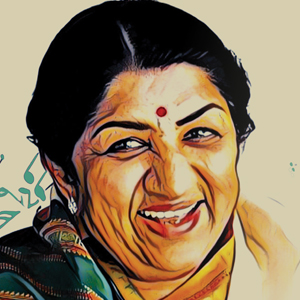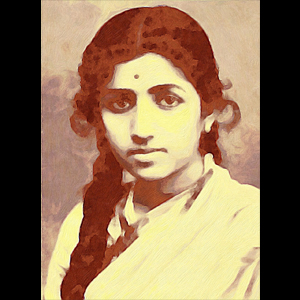Tribute: The Unforgettable Melody Queen

In a career spanning seven decades, she was a favorite of three generations of music lovers. Lata Mangeshkar’s deep musical sensibility absorbed every delicate nuance of each note and her honey-toned voice rendered it with jaw-dropping perfection.
My earliest memories of hearing legendary singer Lata Mangeshkar’s songs are from my childhood, when my mother swayed me in her arms and softly sang to me “Dheere Se Aaja Ri Ankhiyan Mein Nindiya Aaja Ri Aaja….” Lata Ji had originally sung the lullaby for the 1951 film Albela. This song, like many other songs Lata Ji sang, made a lifelong impression on the minds and hearts of millions of music lovers all around the world. Upon listening to the patriotic song “Ae Mere Watan Ke Logon” sung by Lata Ji in honor of those who had lost their lives in the 1962 Indo-China war, even the then Indian Prime Minister, Pandit Jawaharlal Nehru is said to have had tears in his eyes. How did Lata Mangeshkar come to be India’s best-known female singer?
Born in Indore, in the year 1929, Lata Ji commenced taking music lessons, at the tender age of five, from her father, the reputed musician and Marathi theatre artist, Pandit Deenanath Mangeshkar. Soon developing a sound foundation in music, she furthered her classical training under Ustad Aman Ali Khan of Bhendibazaar Gharana.
During her early teens, the unexpected demise of her father put the responsibility of running a household, which had her mother and four younger siblings, upon young Lata’s shoulders. The family moved to Mumbai in the early 1940s and Lata Ji initially accepted acting roles in the film industry. She soon gave up acting in favor of playback singing after a handful of films. The short acting stint, however, equipped her with insights into the world of films.
Lata Ji’s career as a playback singer began under the mentorship of composer Ghulam Haider and took wings in 1948 following the success of the movie Mahal in which she sang “Aayega, Aayega, Aeyega Aaanewala, Aayega”. There was no looking back after that.
In a musical career spanning nearly seven decades, Lata Ji is estimated to have sung and recorded more than 25000 songs in multiple Indian languages, gaining an entry into the Guinness Book of World Records. Between 1945 and 2010, she had the unique distinction of working with almost all the top music composers, lyricists, and directors of the Bollywood film industry.
 It was Lata Ji’s silken voice and versatility that brought her name and fame. Not only was Lata Ji a competent Hindustani classical singer but also someone who could sing semi-classical and film songs in a great variety of musical genres. Whether it was a classical song “Man Mohana Bade Jhoote,” a devotional song “O Paalan Hare,” a western style song “Ajeeb Dastaan Hai Ye,” a love song “Kabhi Kabhi Mere Dil Mein,” or a sentimental Urdu ghazal “Yoon Hasraton Ke Daag,” all of these renditions display the magical throw and modulation of her voice in a range of over three octaves, her flawless diction, effortless ornamentation, command on rhythm, and expression of a wide range of emotions. Lata Ji’s deep musical sensibility absorbed every delicate nuance and her honey-toned voice rendered it with jaw dropping perfection.
It was Lata Ji’s silken voice and versatility that brought her name and fame. Not only was Lata Ji a competent Hindustani classical singer but also someone who could sing semi-classical and film songs in a great variety of musical genres. Whether it was a classical song “Man Mohana Bade Jhoote,” a devotional song “O Paalan Hare,” a western style song “Ajeeb Dastaan Hai Ye,” a love song “Kabhi Kabhi Mere Dil Mein,” or a sentimental Urdu ghazal “Yoon Hasraton Ke Daag,” all of these renditions display the magical throw and modulation of her voice in a range of over three octaves, her flawless diction, effortless ornamentation, command on rhythm, and expression of a wide range of emotions. Lata Ji’s deep musical sensibility absorbed every delicate nuance and her honey-toned voice rendered it with jaw dropping perfection.
Despite her phenomenal versatility, Lata Ji had strong musical preferences and consciously chose not to sing cabaret songs or Marathi Laavani dance songs. One of the rare exceptions to this is when she sang “Aa Jaane Jaan” for Laxmikant-Pyarelal in the movie Intequam. Her younger sister Asha Bhosle had no such reservations and sang, among other songs, some of Bollywood’s finest cabaret numbers. Between 1950 and 1980, the sibling pair Lata and Asha had gained renown as the best female playback singers in the Bollywood film industry. Lata Ji encouraged not only Asha but also inspired her other siblings Usha, Meena, and brother Hridaynath in developing careers in music. Some of the best-known non-film composition albums featuring Lata Ji’s voice, such as Gyaneshwar Mauli and Chala Vahi Des, have been composed by Hridaynath Mangeshkar.
Winner of numerous awards, such as Dadasaheb Phalke award in 1989 and the Bharat Ratna, the highest civilian honor from the Indian government, Lata Ji championed the cause of playback singers for Filmfare Awards. She was instrumental in the creation of a new award category for playback singing. She went on to win a Filmfare Lifetime Achievement Award. Film director Yash Chopra said of her immersion in music, “All of us follow music but in the case of Lata Mangeshkar, music follows her.”
To many music lovers, Lata Ji was Goddess Saraswati incarnate. In my days as a graduate student in the early 90s, I remember the excitement and anticipation of a jam-packed audience at the women’s dormitory in Central University waiting to watch the Wednesday evening television show Chitrahaar that featured a medley of Hindi film songs. Actress Rekha’s lively dancing to the song “Pardesiya, O Pardesiya” from the movie Mr. Natwarlal would be followed by the emotional reunion of Jaya and Amitabh Bachchan in “Tere Mere Milan Ki Ye Raina” from the movie Abhimaan—different actors, different films, different songs but united by the same magical voice of Lata Mangeshkar. Powerful acting by leading actors, when backed by Lata Ji’s magical playback singing, swiftly transported us into the world of our own dreams and desires.
Lata Ji dedicated her life single-mindedly to the pursuit of music. Although she never married, she was married to music. God-fearing, religious, humble, hard-working, and staunch follower of Indian customs and traditions, she was an image of Indian beauty and grace. On hearing of Lata Ji’s demise on Feb 6, 2022, music lover Nagananda Kumar said, “Passing away at the ripe old age of 92 was perhaps to be expected but with Lata Mangeshkar, one wanted otherwise. One wishes she would be there to sing just more song.”
Bharat Ratna Lata Mangeshkar was our link to India’s past and its glory. In her demise, every lover of Indian music feels a numbing sense of grief and a lasting sense of loss.
Shuchita Rao is a Hindustani vocalist from Boston, Massachusetts. She enjoys freelancing on subjects related to Indian music, art, and culture.
Enjoyed reading Khabar magazine? Subscribe to Khabar and get a full digital copy of this Indian-American community magazine.
blog comments powered by Disqus










